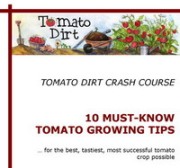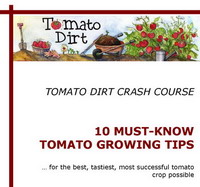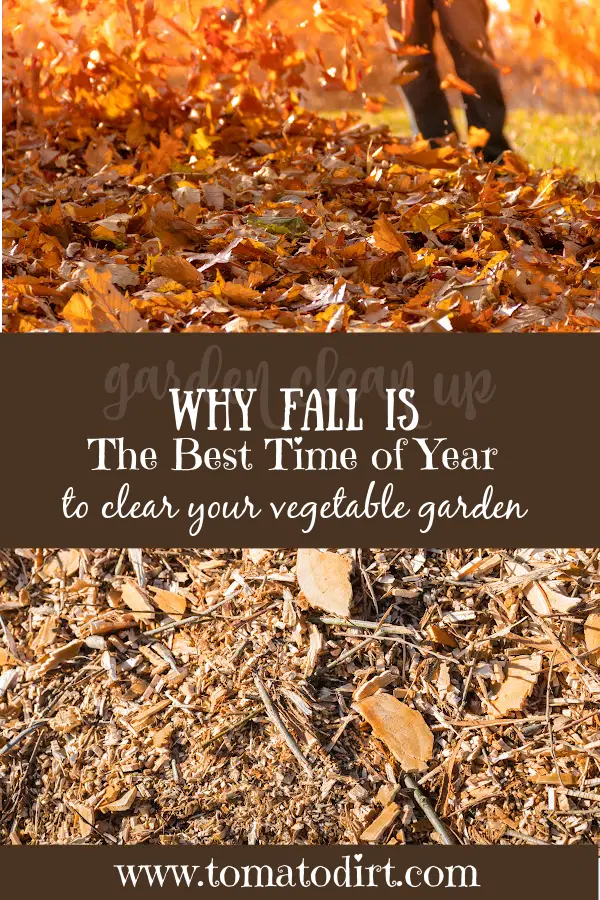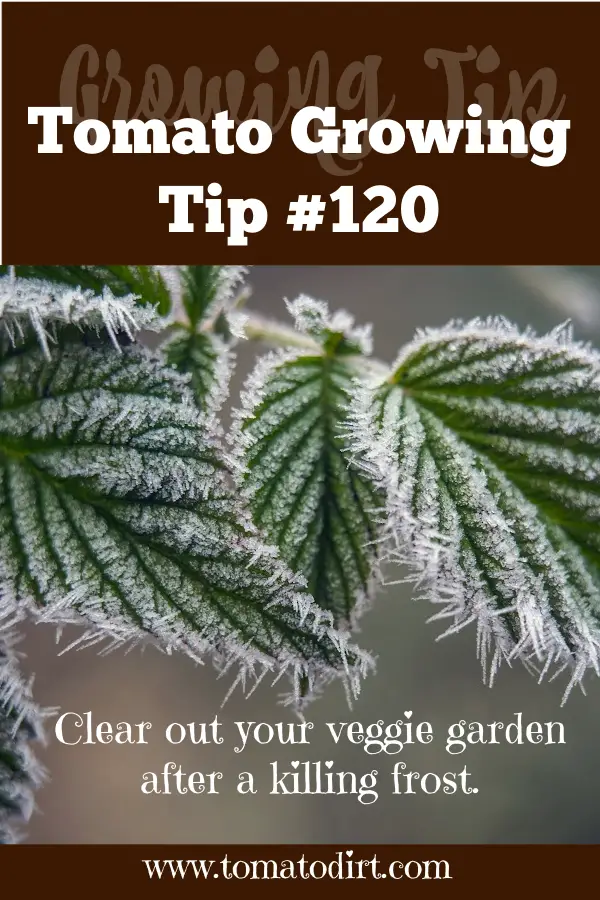FREE: 10 Must-Know Tomato Growing Tips Get The Guide
Read our affiliate disclosure here.
What's the Best Time of Year to Clear a Garden?
Since 2010, Tomato Dirt has garnered 4.8+ million views, making it the web’s leading online source for growing tomatoes in the home garden. Award-winning writer and Tomato Dirt owner Kathy Widenhouse has helped thousands of home gardeners grow healthier tomatoes. Be one of them when you get Tomato Dirt’s Growing Guide here.
Updated 12.1.25
What’s the best time of year to clear a garden? That depends.
No, I’m not being coy. Let me explain.
- The best time to clear a vegetable garden is in the fall.
- The best time of year to clear a garden with flowers and ornamentals? Late fall is ideal for removing dead plants and preparing beds for winter, while late spring (when temperatures are reliably above 50°F), is best for a comprehensive clean-up. The delay allows wildlife a winter habitat.
But back to your veggie patch. The best time of year to clear a garden is in the fall. There are good reasons for that. And there are easy ways to go about it. Read on …
Why is fall the best time of year to clear a vegetable garden?
- You can prevent disease next year. Removing diseased plant debris from the garden reduces the sources of infection for the next growing season.
- You can control pests next year. Many insects and pests overwinter on dead plant material, so clearing it away eliminates their habitat.
- You can control weeds next year. In the fall, you can pull weeds before they drop seeds. Then cover the bare soil with straw, shredded leaves, or manure to suppress new weed growth. Doing so also adds organic matter to the soil, which means …
- You can improve the soil for next year. Fall is an excellent time to add compost or other organic materials to your veggie plot. If your soil test recommends amendments, then add lime or rock phosphate accordingly. Organic matter has time to break down over winter and enrich the soil. If you wait til spring, you miss out.
- You can mark this year’s rows. Use stakes or markers to show where you grew this year’s tomatoes and other crops. This way, you’ll have a good idea how to rotate crops next season to keep soil and plants healthy.
- You can get an earlier start next season. Cleaning up in the fall frees up your time in the spring, allowing you to plant seedlings or direct-sow seeds earlier.
When should I clean up my garden in the fall?
After peak season
You can begin clearing perennials – like asparagus, rhubarb, artichokes and herbs such as oregano, thyme, sage, mint, chives, and rosemary – when their main blooming season is over and they are fading. Clip fading or brown foliage. If it’s healthy, throw it on the compost pile. If not, destroy it. After you trim, you may even get lucky and have a fresh flush to harvest (especially the herbs). As for the rest of your crops …
After a killing frost
Keep an eye on the weather forecast. When you see a hard frost coming your way, harvest the last amount of fresh produce that’s on the vine. Once frost kills your remaining crops, they’ll be easy to remove.
How to clear your garden in the fall
Use these steps to clear your vegetable garden and put it to bed for the winter.
- Remove spent plants. After a frost or when plants are done producing, cut back or pull dead stalks, leaves, and fruit from your vegetable beds. Chop up healthy plant debris and add it to your compost pile. Removing dead foliage helps eliminate overwintering sites for pests.
- Dispose of debris. Gather diseased plants, pest-infested plants, and decaying tomatoes, squash, and other veggies left on the ground. Do not add them to your compost pile. Pathogens can winter over in the compost – and rotting produce can harbor fungal diseases, fruit flies, and rodents. Instead, remove and destroy diseased debris and decomposing produce to prevent bacteria, viruses, and fungi from spreading into next year’s soil and compost.
- Incorporate organic matter. Fall means falling leaves.
You’ve got to clean them up anyway. Why not just dump them in your garden?
Rake leaves or spread straw over the surface of your vegetable garden. If you’re ambitious, till them into the soil. All that luscious organic matter will break down over the winter. You’ll add carbon and nitrogen to the soil – both crucial nutrients for next year’s new crops. Collect extra leaves and debris and add them to the compost pile, which will give you a head start for enriching the soil for the next growing season. - Consider a cover crop. If you finish your cleanup early enough in the fall, you may have time to plant a cover crop, such as a mix of hairy vetch and winter rye, to build soil health.
Why you should not wait until spring to clear out your
vegetable garden
The soil is soggy in the spring
Spring soil can be frozen or very wet and muddy. Try to till it, and you’ll have clods and clumps (I’m speaking from experience here, unfortunately.) It’s hard to work organic matter into the soil when you’re up to your elbows in mud.
You miss opportunities to improve the soil
The best time of year to clear the garden of unwanted diseases and pests is at the end of the growing season. You’ll quash their opportunity to overwinter. Plus, if you wait until spring to clean up your vegetable garden, you won’t have the full advantage of leaves and compost decaying in the soil during the fallow months.
Take advantage of the best time of year to clear your
garden
Garden clean-up is a bit of work at the end of a long season. But if you take steps now, you’ll have a healthier garden next year. Plus, your garden will be orderly and tidy as you look out over it during the winter.
Yes, you’ll need to brush up the garden in spring to get the soil ready for seeds and seedlings. But in the vegetable garden, fall cleanup is the best time of year to clear your garden because of the long-term garden health benefits … and for getting a head start on the next growing season.
More Garden Clean-Up Tips
Free Download: Fall Cleaning Check List for Your Vegetable Garden ...
Tomato Garden Fall Cleaning Checklist, Part 1: Remove Tomato Plants
Tomato Garden Fall Cleaning Checklist, Part 2: Remove Tomato Supports ...
Tomato Garden Fall Cleaning Checklist, Part 3: Turn, Burn, Mulch ...
What To Do After Harvesting Tomatoes ...
3 Mistakes to Avoid When You Prepare Garden for Winter ...
How To Protect Outdoor Pots in Winter ...
How to Take End of Season Notes about Your Tomato Garden ...
When to Remove Tomato Plants in the Fall ...
How to Winterize Your Garden: It's More Than Just Fall Clean Up ...
Spring Garden Clean Up: Get Your Garden Ready for the Season...
Get more tips on our Garden Clean Up Pinterest board...
Return from The Best Time of Year to Clear a Garden to Tomato Dirt home
As an Amazon Associate and Rakuten Advertising affiliate I earn from qualifying purchases.
SHARE THIS PAGE:
FREE! 10 Must-Know Tomato Growing Tips: 20-page guide
Get yours here:





